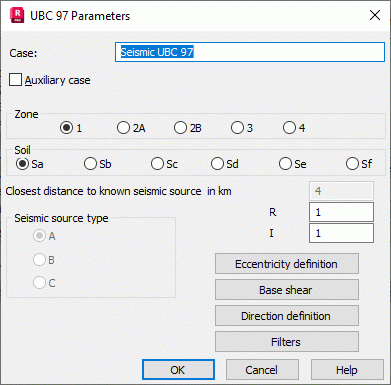Parameters of a structure seismic analysis depend on a seismic code used during calculations of a structure influenced by seismic loads. Select the US seismic code UBC 91 ("The Uniform Building Code 1991") in the New Case Definition dialog or click Parameters in the Analysis Type dialog.

To complete the seismic analysis according to the rules given in a code, define the following parameters:
- Seismic Zone:
Zone = 0, seismic zone coefficient Z = 0
Zone = 1, seismic zone coefficient Z = 0.075
Zone = 2A, seismic zone coefficient Z = 0.15
Zone = 2B, seismic zone coefficient Z = 0.20
Zone = 3, seismic zone coefficient Z = 0.30
Zone = 4, seismic zone coefficient Z = 0.40
- Soil:
Sa - Hard rock
Sb - Rock
Sc - Very dense soil or soft rock
Sd - Stiff soil
Se - Soil
Sf - UBC 1629.3.1
If the site geotechnical evaluation has not been performed, the soil SD should be used.
- Seismic source type.
- R - Response modification factor: values from the interval: from 2.8 (light steel braced frames) to 8.5 (special steel or reinforced concrete structures and dual systems).
- Distance from the closest seismic source.
Seismic acceleration is defined on the basis of Figure 16-3 (design response spectrum) in UBC97 code.
In the lower part of the dialog, the Direction definition and Filters buttons are located.
There is the additional button Base Shear; click it to open the Base shear dialog.
The details concerning this structure analysis method can be found in the mentioned code.
